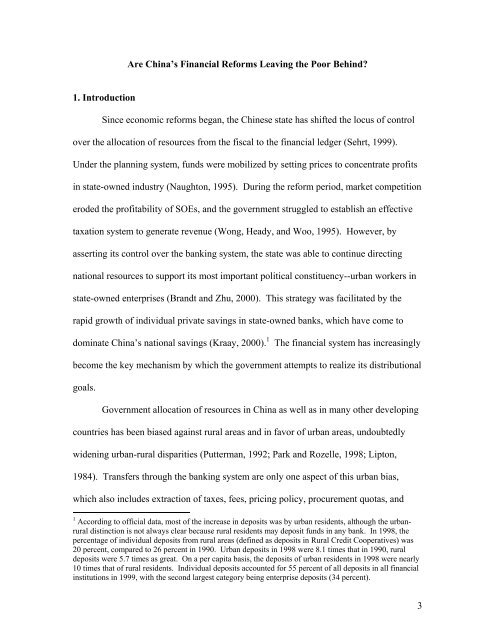Are China's Financial Reforms Leaving the Poor Behind - Harvard ...
Are China's Financial Reforms Leaving the Poor Behind - Harvard ...
Are China's Financial Reforms Leaving the Poor Behind - Harvard ...
You also want an ePaper? Increase the reach of your titles
YUMPU automatically turns print PDFs into web optimized ePapers that Google loves.
<strong>Are</strong> China’s <strong>Financial</strong> <strong>Reforms</strong> <strong>Leaving</strong> <strong>the</strong> <strong>Poor</strong> <strong>Behind</strong>?1. IntroductionSince economic reforms began, <strong>the</strong> Chinese state has shifted <strong>the</strong> locus of controlover <strong>the</strong> allocation of resources from <strong>the</strong> fiscal to <strong>the</strong> financial ledger (Sehrt, 1999).Under <strong>the</strong> planning system, funds were mobilized by setting prices to concentrate profitsin state-owned industry (Naughton, 1995). During <strong>the</strong> reform period, market competitioneroded <strong>the</strong> profitability of SOEs, and <strong>the</strong> government struggled to establish an effectivetaxation system to generate revenue (Wong, Heady, and Woo, 1995). However, byasserting its control over <strong>the</strong> banking system, <strong>the</strong> state was able to continue directingnational resources to support its most important political constituency--urban workers instate-owned enterprises (Brandt and Zhu, 2000). This strategy was facilitated by <strong>the</strong>rapid growth of individual private savings in state-owned banks, which have come todominate China’s national savings (Kraay, 2000). 1The financial system has increasinglybecome <strong>the</strong> key mechanism by which <strong>the</strong> government attempts to realize its distributionalgoals.Government allocation of resources in China as well as in many o<strong>the</strong>r developingcountries has been biased against rural areas and in favor of urban areas, undoubtedlywidening urban-rural disparities (Putterman, 1992; Park and Rozelle, 1998; Lipton,1984). Transfers through <strong>the</strong> banking system are only one aspect of this urban bias,which also includes extraction of taxes, fees, pricing policy, procurement quotas, and1 According to official data, most of <strong>the</strong> increase in deposits was by urban residents, although <strong>the</strong> urbanruraldistinction is not always clear because rural residents may deposit funds in any bank. In 1998, <strong>the</strong>percentage of individual deposits from rural areas (defined as deposits in Rural Credit Cooperatives) was20 percent, compared to 26 percent in 1990. Urban deposits in 1998 were 8.1 times that in 1990, ruraldeposits were 5.7 times as great. On a per capita basis, <strong>the</strong> deposits of urban residents in 1998 were nearly10 times that of rural residents. Individual deposits accounted for 55 percent of all deposits in all financialinstitutions in 1999, with <strong>the</strong> second largest category being enterprise deposits (34 percent).3















